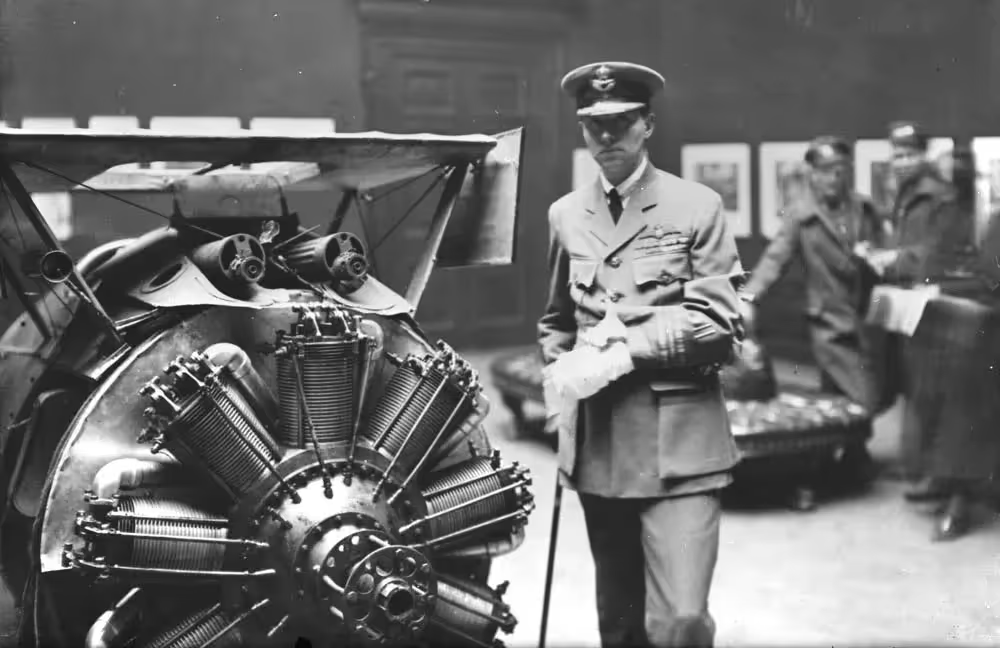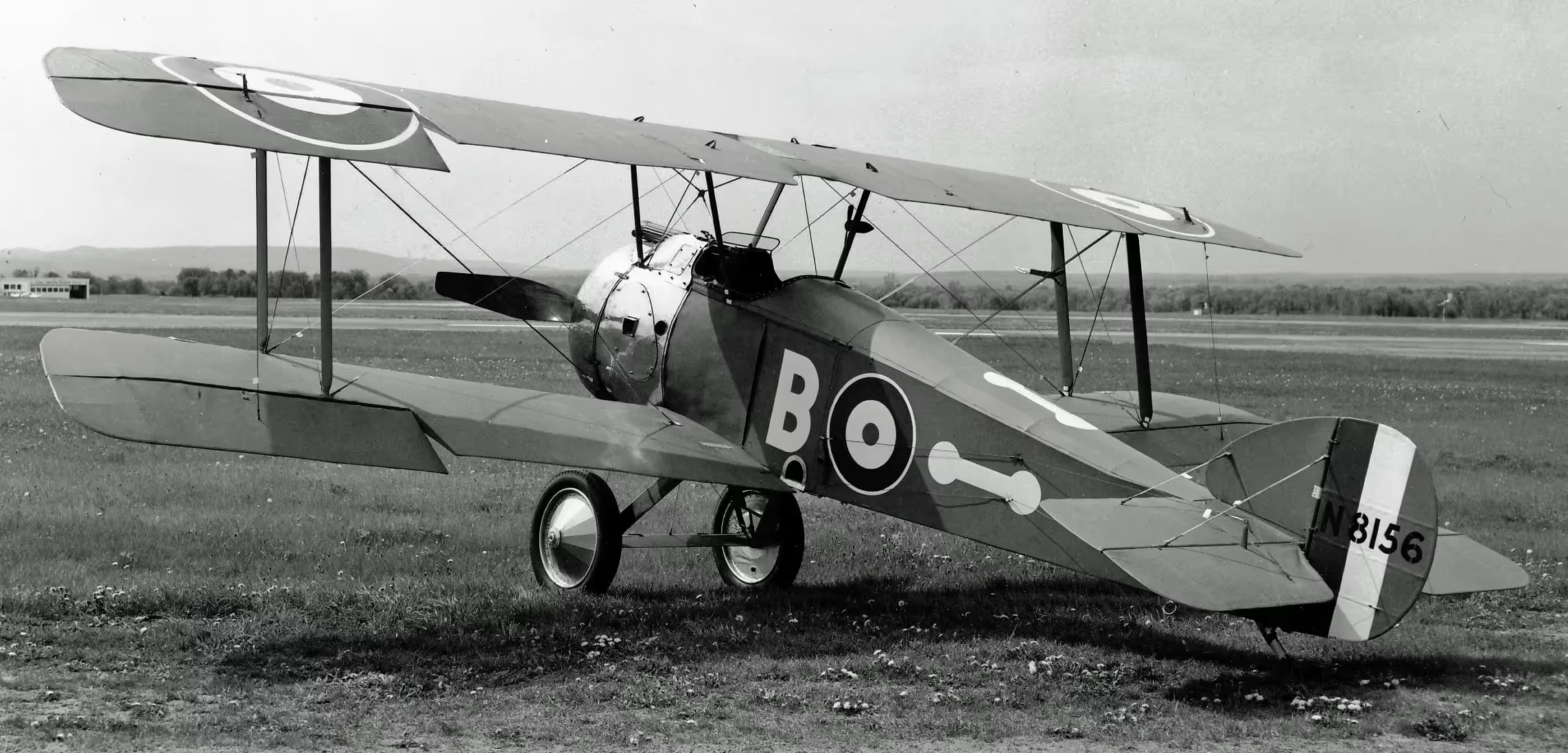Canadian Warplanes 1: Sopwith F.1 Camel
Sopwith F.1 Camel

(Library and Archives Canada Photo, AH-517, PA-172313 and MIKAN No. 3238907)
Sopwith F.1 Camel, Capt William George Barker, VC, DSO & Bar, MC & Two bars, two Italian Silver Medals for Military Valour, and the French Croix de guerre. He was also mentioned in despatches (MiD) three times.
The Sopwith Camel became the most successful British fighter of the First World War. The Sopwith F.1 and 2F.1 Camel first went into operations on the Western Front in 1917 and then served in virtually every theatre of Royal Flying Corps (RFC), Royal Naval Air Service (RNAS) and Royal Air Force (RAF) service. Several Canadian aces used the Camel as their mount. The Camel was very manoeuvrable, and it could be tricky to fly in the hands of a novice pilot. For experienced pilots, however, the aircraft proved to be a superb fighter.
The Camel's machine-guns were mounted on the forward fuselage with their breeches enclosed in a faired metal cowling—a “hump” that gave the Camel its name. Several Camels were also shipped to Canada in the post-war period as part of an Imperial gift. Three registered Sopwith F.1 Camels entered service with the RCAF at Camp Borden in 1924. The following year, the RCAF purchased seven additional aircraft to provide further spares for the active aircraft. These latter aircraft were in fact 2F.1 models that had been “navalized” variants. Used primarily by wartime experienced fighter pilots for refresher training, the Camels lasted another five years before finally being scrapped.

(Library and Archives Canada Photo, MIKAN No. 3214707)
Major William Barker, Feb 1919 in London, alongside the remains of his Sopwith Snipe in which he won the VC.
22 Oct 1918. William George "Billy" Barker was awarded the Victoria Cross for his actions on this day. While returning his Sopwith Snipe to an aircraft depot, he crossed enemy lines at 21,000 feet above the Forêt de Mormal, France. He attacked an enemy Rumpler two-seater which broke up, its crew escaping by parachute (the aircraft was of FAA 227, Observer Lt. Oskar Wattenburg killed). By his own admission, he was careless and was bounced by a formation of Fokker D.VIIs of Jagdgruppe 12, consisting of Jasta 24 and Jasta 44. In a descending battle against 15 or more enemy fighters. The dogfight took place immediately above the lines of the Canadian Corps. Severely wounded and bleeding profusely, Barker force-landed inside Allied lines, his life being saved by the men of an RAF Kite Balloon Section who transported him to a field dressing station. The fuselage of his Snipe aircraft was recovered from the battlefield and is preserved at the Canadian War Museum, Ottawa, Ontario. At a hospital in Rouen, France, Barker clung to life until mid-Jan 1919, and then was transported back to England. He was not fit enough to walk the necessary few paces for the VC investiture at Buckingham Palace until 1 Mar 1919. Barker is officially credited with one captured, two (and seven shared) balloons destroyed, 33 (and two shared) aircraft destroyed, and five aircraft "out of control", the highest "destroyed" ratio for any RAF, RFC or RNAS pilot during the conflict. The Overseas Military Forces of Canada recognized Barker as "holding the record for fighting decorations" awarded in the First World War.
In 1922 he rejoined the fledgling Canadian Air Force in the rank of Wing Commander, serving as the Station Commander of Camp Borden, Ontario from 1922 to 1924. Barker was appointed acting director of the RCAF in early 1924 and he graduated from RAF Staff College, Andover, England in 1926. While waiting to start RAF Staff College Course No. 4, Barker spent two weeks in Iraq with the RAF to learn more about the uses of airpower. He formally reported on his findings to the Minister of National Defence, and informally to Brigadier General Billy Mitchell, of the US Air Service. One of his achievements in the RCAF was the introduction of parachutes.

(Library and Archives Canada Photo, MIKAN No. 3191908)
Major W.G. Barker with wreckage of Sopwith F.1 Camel (Serial No. B6313), No. 28 Squadron, RAF. Barker had an engine failure and carried out a forced landing near Asolo, Italy, on 8 March 1918.

(Library and Archives Canada Photo, MIKAN No. 3390979)
Sopwith F.1 Camel in service, ca. 1918.
3390993

(DND Archives Photo, DND65-90)
Sopwith F.1 Camel, Serial No. N7143, at Turnhouse, Scotland, in 1918. This machine was flown by Lieutenant William S. Lockhart.

(Library and Archives Canada Photo, MIKAN No. 3390993)
Wilfred Leigh Brintnell, O.B.E., in an RAF Sopwith Camel, c1918. He was born in Belleville, Ontario, on 27 August 1895. He was educated at Belleville and Kingston, Ontario, and at the Ontario Business College. In 1917 he joined the Royal Flying Corps (RFC) in Canada and received his Private Pilot's Licence at Deseronto, Ontario, where he became qualified as an instructor. He was assigned to instructional duties with the RFC at Fort Worth, Texas, and the Royal Air Force (RAF) at Camp Borden, Ontario. He was posted to the RAF's Central Flying School, Upavon, England, in 1918 to train on Sopwith Camel fighter aircraft. The war ended before he flew in combat, and he returned to Canada in 1919 to be discharged from service.
https://cahf.ca/wilfred-leigh-brintnell/

(Library and Archives Canada Photo,3523438)W.
Leigh Brintnell at left, Sopwith 1F.1 Camel, RAF, c1918.

Wilfred Leigh Brintnell, O.B.E., in an RAF Sopwith Camel, c1918.

(DND Photo, RE19641-2)
Captain William S. Stephenson beside "his rather time-worn" Sopwith Camel (Serial No. D6---), coded B, in 1918. This photo is from the book, "Knights of the Air, Canadian Fighter Pilots in the First World War" by LCol David L. Bashow (McArthur & Company, Toronto, 2000). On page 193, David notes, "on 28 August 1918, the final battle on the Somme commenced. Naturally, Allied airpower was extensively involved with this counter-offensive. Captain William S. Stephenson of Winnipeg, a twelve-victory ace who had previously won a Military Cross for "conspicuous gallantry and devotion to duty," further distinguished himself through his exploits as a Sopwith Camel pilot with No. 73 Squadron, RAF, being awarded the Distinguished Flying Cross". His citation reads, "This officer has shown conspicuous gallantry and skill in attacking enemy troops and transports from low altitudes, causing heavy casualties. His reports also have contained valuable and accurate information. He has further proved himself a keen antagonist in the air, having during recent operations accounted for six enemy aeroplanes".

(Library and Archives Canada Photo, MIKAN No. 3390976)
Sopwith F.1 Camel, being armed with bombs, No. 203 Squadron, Allonville, France, July 1918.

(Library and Archives Canada Photo, MIKAN No. 3214135.
Major Raymond Collishaw, Commanding Officer, in a Sopwith F.1 Camel Aircraft of No. 203 Squadron, RAF, Izel-le-Hameau (Filescamp Farm), France, 12 July 1918.

(Library and Archives Canada Photo, MIKAN No. 3214136).
Pilots with Sopwith F. 1 Camel aircraft of No. 203 Squadron, RAF, Izel-le-Hameau (Filescamp), France, 12 July 1918. (Left to right): Maj. Raymond Collishaw, Capt. A.T. Whealy.

(Library and Archives Canada Photo, MIKAN No. 3214137).
Pilots with Sopwith F. 1 Camel aircraft of No. 203 Squadron, RAF, Izel-le-Hameau (Filescamp), France, 12 July 1918. (Left to right): Maj. Raymond Collishaw, Capt. A.T. Whealy.

(Library and Archives Canada Photo, MIKAN No. 3585191)
Sopwith 2F.1 Camel.

(Marlene Lawrence Photo)
Sopwith 2F.1 Camel, Reg. No. N8204. Taken on charge by Canada on 12 August 1925 after being purchased from the RAF in UK. N8204 arrived at Camp Borden, Ontario, in August 1925, where it was held as a source of spare parts for 3 Camels operated as trainers at Camp Borden. It may never have been completley assembled or flown in Canada. It was struck off charge on 18 November 1928. N8204 is shown here in a Vocational School in Saint John, New Brunswick in the late 1920s-early 1930s.

(Library and Archives Canada Photo, MIKAN No. 3390990)
Sopwith F.1 Camel, RAF (Serial No. B3802), ca 1918.

(Library and Archives Canada Photo, MIKAN No. 3584525)
Sopwith F.1 Camel project, RCAF Station Rockcliffe, Ontario, 9 Jun 1951.

(DND Photo)
Sopwith 2F.1 Ship's Camel (Serial No. N8156), Canada Aviation and Space Museum.
The Museum's 2F.1 Ship's Camel was manufactured by Hooper and Company Limited of London, England in late 1918. One of the last Camels to be produced, it was not completed in time to serve during the First World War. It was, however, used by the RAF until 1925, when it was transferred to Canada along with six other Ship Camels.
The Camel was used by the RCAF for demonstration flights and as a training airframe. It was loaned to the Canadian War Museum in 1957, and was later stored and displayed at the National Research Council in Ottawa. Restored between 1958 and 1959, and made airworthy between 1966 and 1967, the aircraft was flown between May and June of that year before being transferred to the Museum.

(DND Archives Photo, PCN-4592)
Sopwith 2F.1 Ship's Camel (Serial No. N8156), Canada Aviation and Space Museum.

(Library and Archives Canada Photo, MIKAN No. 3390977)
French soldiers examining Sopwith 1F.1 Camel fighter (Serial No. E4389) of the RAF which landed inside Canadian lines near Amiens, France, August 1918. The vertical bars indicate the aircraft is from No. 209 Squadron, RAF, the same squadron as Capt Roy Brown.

(Library and Archives Canada Photo, MIKAN No. 3390991)
Sopwith 1F.1 Camel fighter (Serial No. B5166) of the RAF.

(RAF Photo)
HMA R.23 airship with the underslung Sopwith Camel (Serial No. N6814), 1918.





